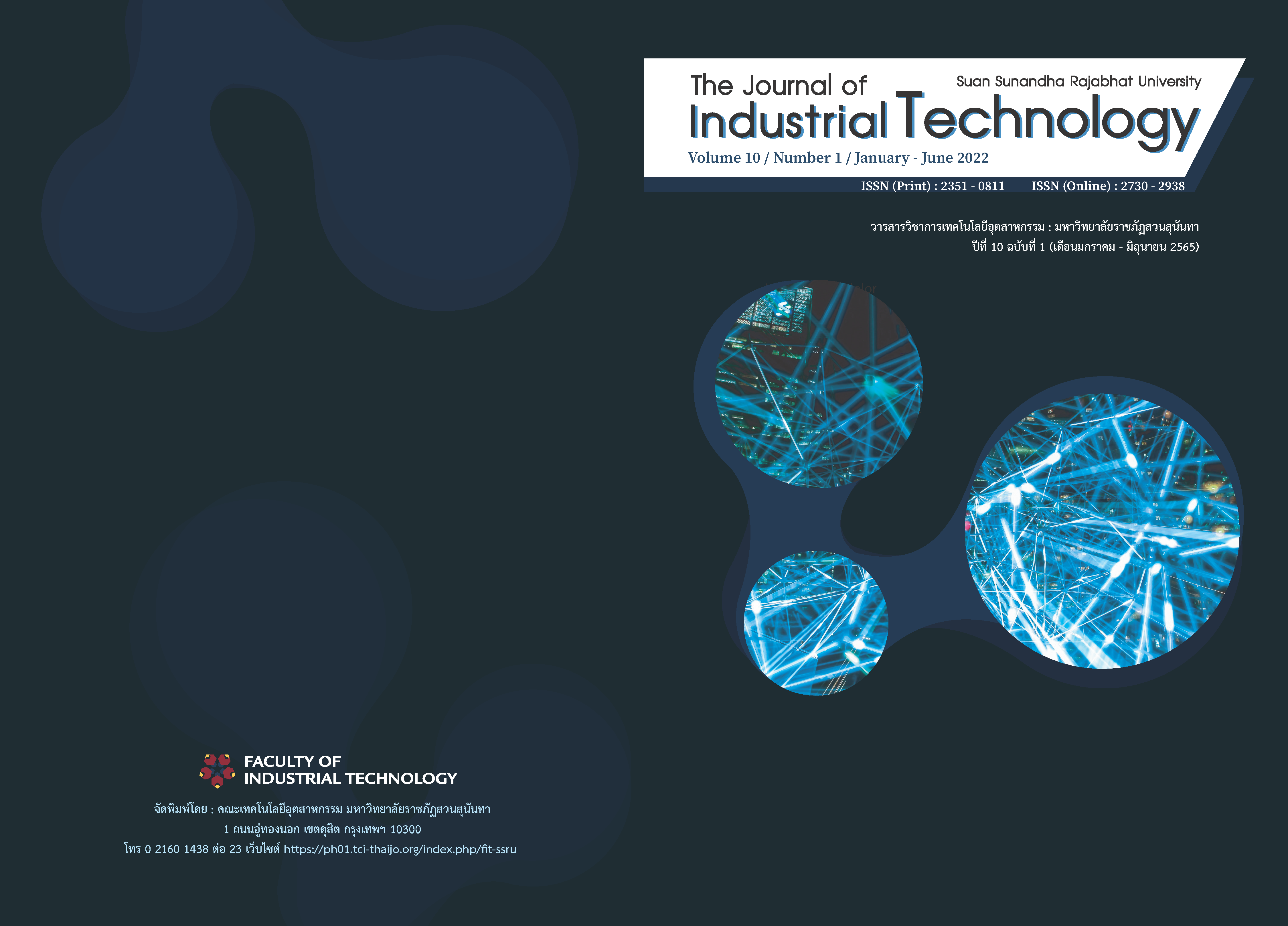กำลังยึดหน่วงระหว่างเหล็กเสริมที่เคลือบอีพ็อกซี่กับคอนกรีตที่ ผสมเถ้าชานอ้อย
คำสำคัญ:
กำลังยึดหน่วง, กำลังอัด, อีพ็อกซี่, เถ้าชานอ้อย, เหล็กเสริมบทคัดย่อ
บทความนี้ทำการศึกษาเกี่ยวกับผลกระทบของการใช้อีพ็อกซี่เป็นวัสดุเชื่อมประสานระหว่างเหล็กเสริมกับคอนกรีตที่ผสมเถ้าชานอ้อย โดยทดลองหล่อตัวอย่างคอนกรีตขนาด 150 150 150 มม. มีเหล็กข้ออ้อยขนาดเส้นผ่านศูนย์กลาง 12 มม. เสริมอยู่ที่จุดกึ่งกลางของหน้าตัดมีระยะฝังเท่ากับ 50 มม. คอนกรีตที่ใช้มีเถ้าชานอ้อยผสมทดแทนปูนซีเมนต์ปอร์ตแลนด์ประเภทที่ 1 ในอัตราส่วนร้อยละ 0, 10, 20, 30 และ 40 โดยน้ำหนัก จำลองตัวอย่างให้มีลักษณะการยึดหน่วง 2 แบบ คือ ฝังเหล็กเสริมพร้อมหล่อคอนกรีตกับเจาะคอนกรีตในภายหลัง แล้วเสริมเหล็กโดยใช้อีพ็อกซี่เป็นวัสดุเชื่อมประสาน ทำการทดสอบตัวอย่างเมื่อคอนกรีตมีอายุครบ 3, 7, 28, 60 และ 90 วัน ผลการทดลองแสดงให้เห็นว่า การใช้อีพ็อกซี่มีผลให้กำลังยึดหน่วงในช่วง 7 วันแรก มีค่ามากกว่ากรณีฝังเหล็กเสริมพร้อมหล่อคอนกรีตถึงประมาณร้อยละ 12 โดยต้องผสมเถ้าชานอ้อยในอัตราส่วนไม่เกินร้อยละ 20 สำหรับในระยะยาว ตัวอย่างที่ทดสอบทั้ง 2 กรณี ให้กำลังยึดหน่วงไม่แตกต่างกัน
เอกสารอ้างอิง
Batool F, Masood A and Ali M. Characterization of Sugarcane Bagasse Ash as Pozzolan and Influence on Concrete Properties. Arabian Journal for Science & Engineering (Springer Science & Business Media B.V. ). 2020; 45(5): 3891-3900.
Chindaprasirt P, et al. Mechanical properties, chloride resistance and microstructure of Portland fly ash cement concrete containing high volume bagasse ash. Journal of Building Engineering. 2020; 31: 101415.
Ganesan K, Rajagopal K and Thangavel K. Evaluation of bagasse ash as supplementary cementitious material. Cement and Concrete Composites. 2007; 29: 515-524.
Jha P, Sachan AK and Singh RP. Agro-waste sugarcane bagasse ash (ScBA) as partial replacement of binder material in concrete. Materials Today: Proceedings. 2021; 44(Part 1): 419-427.
Khobklang P, Nokkaew K and Greepala V. Effect of Bagasse Ash on Water Absorbtion and Compressive Strength of Lateritic Soil Interlocking Block, in Excellence in Concrete Construction- through Innovation, Limbachiya MC, Editor. 2008, Kingston University: London, UK.
Loganayagan S, Chandra Mohan N and Dhivyabharathi S. Sugarcane bagasse ash as alternate supplementary cementitious material in concrete. Materials Today: Proceedings. 2021; 45(Part 2): 1004-1007.
Pritish Gupta Q, Eric W and Chandradeo B. Sustainable concrete: Potency of sugarcane bagasse ash as a cementitious material in the construction industry. Case Studies in Construction Materials. 2021; 14(e00545-).
Sujjavanich S, et al. Effect of Bagasse Ash as Cementitious Material. In. Proceeding in NOCMAT/3-Vietnam International Conference on Non-Conventional Materials and Technologies; March 12-14; Hanoi, Vietnam 2002
American Society for Testing and Materials. Standard Specification for Coal Fly Ash and Raw or Calcined Natural Pozzolan for Use in Concrete, in Concrete and Aggregates. 2004, ASTM International: West Conshohocken, United States.
Dumrongsil S and Thepwong R. Strength and Microstructure of Cement Blended Bagasse Ash and Fly Ash. 2007, Rajamangala University Of Technology Rattanakosin: Bangkok, Thailand. p. 19.
Tancharoen S and Suwansaard A. The Study of Proportion of Bagasse Ash Affecting to Compressive Strength of Concrete. The Journal of Industrial Technology. 2022; 18(1): 12.
Barbosa AF and Ribeiro GO. Analysis of Reinforced Concrete Structures using ANSYS Nonlinear Concrete Model. Computational Mechanics. 1998; 19(3): 50.
Ferguson PM, Breen JE and Jirsa JO. Reinforced Concrete Fundamentals. 5th ed. 1991, United States of America: John Wiley and Sons, Inc. 768; 1991
Nilson AH, Darwin D and Dolan CW. Design of Concrete Structures. 15th ed. ed, ed. Darwin D and Dolan CW. 2015, Boston: McGraw-Hill Higher Education; 2015
Abrishami HH and Mitchell D. Analysis of Bond Stress Distributions in Pullout Specimens. Journal of Structural Engineering. 1996; 122(3): 255.
Arezoumandi M, Looney TJ and Volz JS. Effect of fly ash replacement level on the bond strength of reinforcing steel in concrete beams. Journal of Cleaner Production. 2015; 87(1): 745-751.
Arezoumandi M, Wolfe MH and Volz JS. A comparative study of the bond strength of reinforcing steel in high-volume fly ash concrete and conventional concrete. Construction and Building Materials. 2013; 40: 919-924.
Chang EH. Shear and Bond Behaviour of Reinforced Fly Ash-Based Geopolymer Concrete Beams, in Civil Engineering. 2009, Curtin University of Technology: Perth. p. 410.
Gomaa E, et al. Bond strength of eco-friendly class C fly ash-based thermally cured alkali-activated concrete to portland cement concrete. Journal of Cleaner Production. 2019; 235: 404-416.
Jiong-Feng L, et al. Bond behavior between high volume fly ash concrete and steel rebars. Computers & Concrete. 2017; 19(6): 625-630.
Li Q, et al. Bond characteristics between early aged fly ash concrete and reinforcing steel bar after fire. Construction and Building Materials. 2017; 147: 701-712.
Liang JF, et al. Bond behavior between high volume fly ash concrete and steel rebars. Computers and Concrete. 2017; 19(6): 625-630.
Manjunath R, Narasimhan MC and Suryanarayana LR. Bond strength characteristics of fly ash admixed self-compacting alkali activated concrete mixes. 2020, INDIAN CONCRETE JOURNAL: India. p. 50-58.
Zhou Q, et al. Effect of fly ash and corrosion on bond behavior in reinforced concrete. In: 2020/01/01/: Thomas Telford; 2020. p. 1839-1852.
American Society for Testing and Materials. Standard Test Method for Compressive Strength of Cylindrical Concrete Specimens. 2017, ASTM International: West Conshohocken, PA.
American Society for Testing and Materials. Standard Test Method for Pullout Strength of Hardened Concrete. 2001, ASTM International: West Conshohocken, PA, United State of America.
Ahmed KS, et al. Bond strength of post-installed high strength deformed rebar in concrete. Case Studies in Construction Materials. 2021; 15: e00581.
Shang H, Shao S and Wang W. Bond behavior between graphene modified epoxy coated steel bars and concrete. Journal of Building Engineering. 2021; 42: 102481.
ดาวน์โหลด
เผยแพร่แล้ว
รูปแบบการอ้างอิง
ฉบับ
ประเภทบทความ
สัญญาอนุญาต
ลิขสิทธิ์ (c) 2022 คณะเทคโนโลยีอุตสาหกรรม มหาวิทยาลัยราชภัฏสวนสุนันทา

อนุญาตภายใต้เงื่อนไข Creative Commons Attribution-NonCommercial-NoDerivatives 4.0 International License.
บทความที่ได้รับการตีพิมพ์เป็นลิขสิทธิ์ของคณะวิศวกรรมศาสตร์และเทคโนโลยีอุตสาหกรรม มหาวิทยาลัยราชภัฎสวนสุนันทา
ข้อความที่ปรากฏในบทความแต่ละเรื่องในวารสารวิชาการเล่มนี้เป็นความคิดเห็นส่วนตัวของผู้เขียนแต่ละท่านไม่เกี่ยวข้องกับมหาวิทยาลัยราชภัฎสวนสุนันทา และคณาจารย์ท่านอื่นๆในมหาวิทยาลัยฯ แต่อย่างใด ความรับผิดชอบองค์ประกอบทั้งหมดของบทความแต่ละเรื่องเป็นของผู้เขียนแต่ละท่าน หากมีความผิดพลาดใดๆ ผู้เขียนแต่ละท่านจะรับผิดชอบบทความของตนเองแต่ผู้เดียว








